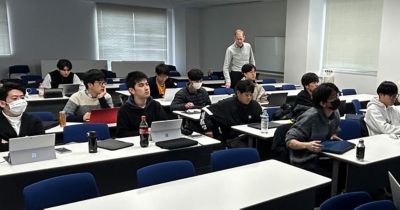Case Study
“I have used various commercial optical design software solutions, and I consider Ansys Zemax OpticStudio to be the easiest for beginners to learn. Thus, it is best suited to teaching at a university. As my students graduate and enter the workforce, I believe, at some point, they may reflect on their experience with the software and apply it to professional life.”
— Nathan Hagen, Professor, Utsunomiya University
Nathan Hagen, a professor at Utsunomiya University, introduces lens optical design techniques to students pursuing an optical engineering master's degree using available commercial software. The class mixes lectures on aberration theory and practical design techniques, which are introduced and applied using commercial software to work on basic lens designs. His instructional goals are to help students gain an understanding of optical design — what software is available, what it feels like to use it, and what they can do with it. Through this method of instruction, he hopes to cultivate an experience his students will look to in their professional lives to inform their own work in an optical design environment.
Challenges
Utsunomiya University students are pressed to find the time required to master optical design before graduation. In Japan, much of this training will happen after graduation, once they become employees of companies offering large internal training programs.
In direct contrast, Prof. Hagen himself completed four lecture courses related to optical design as a graduate student before taking his first lens design course. This required him to spend approximately 12 hours per week (180 hours per semester) on courses. Yet even after this initial training, Hagen still needed more instruction before he could be an independent designer and eventually pass on his knowledge to his students.
As a professor, Hagen was tasked with the distillation of all his learnings into a comprehensive optical design course that exposes students to an array of design principles in the context of a single semester.
Instructional Solution
Throughout the term, Professor Hagen uses Ansys Zemax OpticStudio software during his course to illustrate and reinforce many of the optical design principles his lectures are based on. The first half of his 90-minute class is a lecture, followed by a lab using OpticStudio. It's during this second 45-minute period that students are asked to open the software to try and run the same sequence of steps shown during the lecture. If a student gets stuck on something, Professor Hagen will help them before continuing with instruction. Homework is assigned after each class, which requires students to use the software to do additional basic optical design. This class cadence is repeated throughout the term to build on and reinforce optical design principles in a simulation-driven environment.

Nathan Hagen is a professor in the optical engineering department at Utsunomiya University, where he teaches courses in Geometric Optics, Radiometry, and Optical System Design.

The Center for Optics Research Education on the Utsunomiya University campus.
Benefits
- By introducing Ansys optical simulation software into his lectures, Professor Hagen helps students make meaningful, valuable connections between what they hear during class and the basic lens designs they are able to achieve in a virtual environment. This facilitates greater comprehension and retention.
- Through OpticStudio, students gain exposure via assignments covering topics including pupil position/lens radii optimization of a singlet lens/pupil, adding a field-flattening lens to a symmetric doublet, and converting singlets into achromatic doublets for further optimization.
- Based on instruction time in the classroom, regular homework is given that enables students to receive additional real-world experience using optical simulation to do basic optical design work.
- Setting up a license server enables students to access OpticStudio from any on-campus location at any time until the class is over, affording them ample time to complete and submit their work.
- Additional OpticStudio software licenses are also provided from time to time to students requesting them in support of research projects done outside of the classroom.
- While much of their training begins after graduation in corporate settings, Hagen is hopeful that practical experience using OpticStudio in a classroom environment will contribute to his students' career success in the future.

Professor Hagen delivering a lecture on optics to graduate students at Utsunomiya University.

This lens rendering in Ansys Zemax OpticStudio was part of a homework assignment for the Lens Design class, where students are tasked to create a symmetric doublet lens, then add a field flattening lens to reduce the field curvature. The result is a crude form of Petzval lens.
现在就开始行动吧!
如果您面临工程方面的挑战,我们的团队将随时为您提供帮助。我们拥有丰富的经验并秉持创新承诺,期待与您联系。让我们携手合作,将您的工程挑战转化为价值增长和成功的机遇。欢迎立即联系我们进行交流。